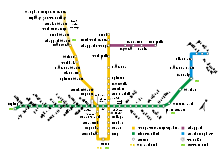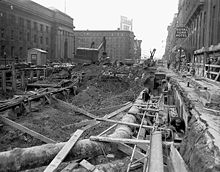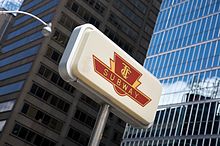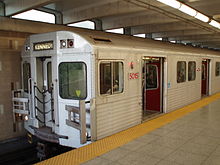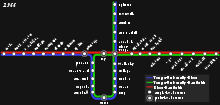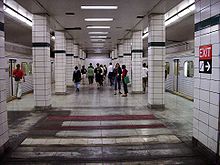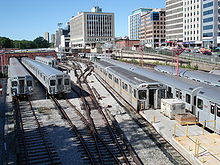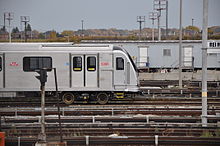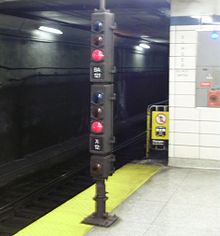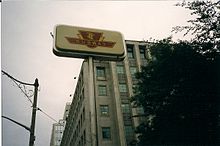- Toronto subway and RT
-
Toronto Subway and RT 
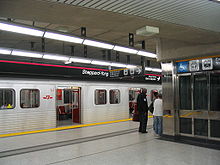
A T-series train at Sheppard–Yonge station on the Sheppard line.Info Locale Toronto, Ontario, Canada Transit type Rapid transit Number of lines 4 Number of stations 69 (6 more under construction) Daily ridership 948,100 (avg. weekday, 2010)[1] Website http://www3.ttc.ca/ Operation Began operation March 30, 1954 Operator(s) Toronto Transit Commission (TTC) Number of vehicles 706 subway and RT cars; 62 work cars Train length 4 and 6 car trains Headway 2mins 21seconds (min) -
5mins 30seconds (max)[2]Technical Track gauge 4 ft 10 7⁄8 in (1,495 mm) (subway)
1,435 mm (4 ft 8 1⁄2 in) (SRT)Electrification Third rail 600 V DC (subway)
Third rail, linear induction (SRT)System map The Toronto subway and RT is a rapid transit system in Toronto, Ontario, Canada, consisting of both underground and elevated railway lines, operated by the Toronto Transit Commission (TTC). It was Canada's first completed subway system, with the first line being built under Yonge Street, which opened in 1954 with 12 stations. Since then, the system has expanded to become Canada's largest rapid transit rail network and the second busiest, behind the Montreal Metro, in number of daily ridership, encompassing four lines and 69 stations on 70 kilometres (43 mi) of track.[3] The subway system is a very popular mode of public transport in Toronto, with an average of 948,100 passenger trips each weekday (as of Q1 2010).[1]
The TTC sometimes uses the term "rapid transit" internally to describe all four lines,[4] but in public usage they are called subway lines, with the exception of the Scarborough RT, which is simply called "the RT."
Current priorities for expansion is extending the western branch of the Yonge–University–Spadina line north of Toronto, creating a new line under Eglinton Avenue, and extending the Sheppard line in both directions from its current termini.
Contents
System map
Subway and RT system map Yonge–University–Spadina
Between Finch and Downsview via UnionBloor–Danforth
Between Kipling and KennedyScarborough RT
Between Kennedy and McCowanSheppard
Between Sheppard–Yonge and Don MillsHistory
Early proposals
The first serious proposal for a subway system in Toronto was made in the early part of the 20th century, with a series of proposals to bury the streetcar line on Yonge. A number of proposals emerged between 1909 and 1912, but the public rejected subways in a plebiscite in 1912, and discussions ended for a time.[5] In 1931, City Controller Hacker proposed a north-south subway running from Avenue Road and St. Clair south to Front and York Streets, making a wide loop via Front, Scott, Victoria and Gerrard.[6]
Yonge route
During World War II, workers travelling from their homes in "northern Toronto" (parts that would now be considered part of the core) to the industrial areas to the east and west of the downtown area on Yonge seriously strained the existing road and streetcar networks. There was considerable worry that the expected post-war boom in car ownership would choke the city with traffic.
The TTC formed a Rapid Transit Department and studied various solutions between 1942 and 1946, finally deciding on a cut-and-cover route that would allow streetcars to travel underground from Eglinton Avenue to Front Street, and then the short distance westward along Front to Union Station. In addition, a cut would allow the existing Queen Street streetcars to run underground from just east to just west of Yonge, and then for an additional short distance in an open cut to the west. The matter was put to voters on a 1 January 1946, plebiscite and overwhelmingly approved. Toronto City Council approved construction four months later.[5]
The plebiscite contained the condition that the federal government would subsidize 20% of the project. The federal Minister of Reconstruction, C.D. Howe, promised federal support in a 3 October 1945 letter. However, the funding fell through over a disagreement about the details of the employment arrangements. A scaled down proposal, about 20% smaller, was agreed to in its place. The work along Queen Street was abandoned temporarily, and the original $42.3 million was reduced to $28.9 million plus $3.5 million for rolling stock.[5] Due to a two-year delay due to postwar labour shortages, construction on the new subway did not start until 8 September 1949. A total of 1.7 million cubic yards (1.3 million cubic metres) of material was removed and some 14,000 tons (12,700 metric tons) of reinforcing steel and 1.4 million bags of cement were put into place.[5]
Since the system was envisioned as an expansion of the existing streetcar network, the current subway system retains one feature unique to the Toronto system. The streetcar system was originally installed on dirt roads used by wagon traffic. In order to allow the wagons to continue using the same roads, as well as to reduce wear and tear on the dirt portions, the streetcar rails were designed to allow the wagon wheels to run within the rail, while the streetcar wheels would run on top of them. Since the days of the Roman Empire, wagons have used standard gauge at 4 feet 8 ½ inches, so the streetcar gauge had to be slightly wider, and runs at 4 feet 10 ⅞ inches. Rolling stock for the new "rapid transit subway" also adopted this gauge.
Service on the Yonge route would be handled by new rolling stock, and the TTC was particularly interested in the Chicago PCC cars, which had been adapted from existing streetcars. However, due to the onset of the Korean War, metal prices in the United States had substantially increased, resulting in the PCC cars becoming too expensive. Instead, in November 1951 an order was placed with the Gloucester Railway Carriage and Wagon Company for 104 cars for $7,800,000, including spare parts.
Ontario Premier Leslie Frost and Toronto Mayor Allan A. Lamport officially opened the 7.4 km (4.6 mi) long Yonge subway on 30 March 1954. Trains operated at average speeds of 20 miles per hour (32 km/h).[7] The route was an instant success. The original plan to operate two-car trains during off-peak hours was abandoned in favour of four-car trains, and six-car trains were standard during most periods, with some eight-car trains used during peak periods.
The 1960s to the 1980s
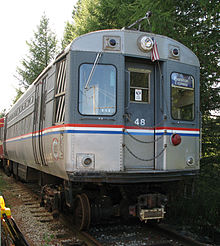 The TTC originally intended the subway to use streetcar-derived trains, like this former Chicago 'L' train preserved at the Halton County Radial Railway
The TTC originally intended the subway to use streetcar-derived trains, like this former Chicago 'L' train preserved at the Halton County Radial Railway
In 1963, an extension was added, curving north from Union station, below University Avenue and Queen's Park to near Bloor Street, where it turned west to terminate at St. George and Bloor Streets.
The Bloor-Danforth Line opened in 1966 along Bloor Street and Danforth Avenue from Keele Street to Woodbine Avenue, and was extended in 1968 to run from Islington Avenue to Warden station at Warden and St. Clair Avenues. For six months, the subway was operated as a single system, with trains from Eglinton station running through to either Keele or Woodbine, while other trains connected the latter two points; after this the two lines were permanently segregated.
The routing of the line across the Don Valley was possible thanks to a decision made more than forty years earlier. When the Prince Edward Viaduct was built in 1918, its designer insisted on providing for twin decks below the roadway to allow for future rail traffic. As a result, the subway is able to cross the Don Valley to Danforth Avenue on the east side.
The Yonge-University line was extended north 8.7 km (5.4 mi) from Eglinton Avenue to Finch Avenue and Yonge in 1973 and 1974.
A further 9.9 km (6.2 mi) was added to the Yonge-University Line in 1978 when it was extended from St. George and Bloor, running north and northwest to Eglinton Avenue and William R. Allen Road, then north along the median of the Allen Road to Wilson Avenue. This extension was originally proposed as part of the Spadina Expressway, but when the expressway portion south of Eglinton Avenue was cancelled, the subway was still built following the original route through Cedarvale Ravine. Hence, it is called the Spadina subway line, though it follows Spadina Road for less than 2 km (1.2 mi).
In October 1976, an arson caused the destruction of four subway cars and damage to Christie station, resulting in the closure of the Bloor-Danforth Line for three days, and the by-passing of Christie station for some time afterwards for repairs. Extensions were added in 1980 at both ends of the Bloor-Danforth Line. These extensions each added a single station, much needed bus bays to connect to surface routes, and, on the eastern end, room to connect to the Scarborough RT.
Spanning six stations over 6.8 km (4.2 mi) of track, the Scarborough RT is an intermediate-capacity line built almost entirely above ground, which has no direct track connections to the other lines and uses a separate fleet of Intermediate Capacity Transit System (ICTS) trains based on dramatically different technology (similar to the those on the Vancouver SkyTrain). Nevertheless, its operating practices are the same as those of the three subway lines: the route is fully isolated from road traffic and pedestrians, the stations are fully covered, and the trains are boarded through many doors from high platforms within a fare-paid zone set off by a barrier. The TTC therefore includes it with the other rapid transit lines for mapping and administrative purposes.
Since the 1990s
An additional 1.6 km (1.0 mi) was added to the north end of the Spadina section of the Yonge-University-Spadina Line, adding one station (Downsview), with bus bays for connections to surface routes. At the time, a newly elected provincial Progressive Conservative government cancelled their share of funding that would have extended this route northward to York University and Steeles Avenue. This extension is under construction, and funding has been committed by governments (see Future expansion).
In August 1995, the TTC suffered the deadliest subway accident in Canadian history known as the Russell Hill accident, on the Yonge-University-Spadina Line south of St. Clair West station. Three women died and 100 people were injured, a few seriously. This led to a major reorganization at the TTC, since contributing to maintaining a "state of good repair" (i.e., an increased emphasis on safety and maintenance of existing TTC capital/services) and less so on expansion.
The subway's newest line, Sheppard, opened in 2002. It was the only one of three subway projects backed in the mid-1990s by the Rae government to be completed. It runs 5.5 km (3.4 mi) east, underneath Sheppard Avenue from Sheppard station on the Yonge line (now renamed Sheppard-Yonge), to Don Mills station at Sheppard and Don Mills Road. The Sheppard line has fewer users than the other two subway lines, and shorter trains are run.
In its over fifty-year history, the first baby to be born on a TTC subway station platform occurred on February 6, 2006.[8] This incident occurred at Wellesley station and caused delays on the subway system.[8] It was front-page news for many days.[9]
An automated voice system was added to announce each station (e.g., "The next station is Bloor, Bloor station.") and replace the need for the train operator to announce each stop. The automated system is used throughout the entire subway and RT system. The system uses a pre-recorded female voice taken from one of the TTC employees. Station announcements by the operators originally commenced on January 8, 1995, under pressure from visually-impaired advocate groups. However, this policy was not enforced and announcements were sporadic until the TTC began to enforce the policy in around 2005, until automated announcements could be implemented under further pressure from the advocate groups. Years later, the automated stop announcements were expanded on TTC surface routes which also have the LED board indicating the next stop. However, while the surface route automatic announcements are both audible and visible, it is not until new subway trains arrive in the Toronto subway system will provide audible and visible automatic stop announcements. The Ontario Human Rights Commission later urged other transit operators across Ontario, such as York Region Transit, Brampton Transit, MiWay (formerly known as Mississauga Transit), GO Transit and Durham Region Transit, to call out all stops for the visually-impaired passengers.[10][11]
Operations and procedures
Like most subways, the Toronto subway/RT trains collect their electric power from a third rail mounted alongside the tracks. 'Shoes' mounted on the trucks are located on both sides of each coach for the required contact. Power is supplied at 600 V DC. Scarborough RT trains cannot switch directions except at the ends of the line as there are no turnback switches between the two termini. In contrast, the subway system was built in multiple segments, thereby providing multiple x-pattern crossovers. Current service patterns do not provide regular short turn service aside from the procedure at St. Clair West in the AM rush hour; however, the flexible crossovers have come in handy during emergencies where service is suspended in certain areas. Subway trains maintain their normal schedule, serving every station on a particular line, except during the morning and evening rush hours when some northbound trains short-turn at the St. Clair West station or, in rarer cases, Glencairn station. Electric-mechanical signs, left over from the 1966 integrated subway lines experiment, were used to indicate if a train was going to short turn or not. This service was discontinued in 2004, though the signs were not even used at all in various stations.
Safety procedures have progressed over time, usually in response to a mishap. One such incident was in March 1963, when there was an electrical short in a subway car's motor. The driver decided to continue operating the train, despite visible smoke in the affected car, until the train reached Union station. This decision resulted in the destruction of six subway cars and extensive damage to the tunnel and signal lines west of Union station. Following this incident safety procedures, involving electrical malfunctions and/or fire in subway trains, were revised to improve safety and reduce the likelihood of a similar incident occurring.
GO Transit commuter trains stop at or near the Kipling (GO's Kipling station), Dundas West (GO's Bloor station), Main Street (GO's Danforth station), Leslie (GO's Oriole station), and Kennedy (GO's Kennedy station) subway stations. The TTC's Union subway station connects with Union Station, Toronto's main railway station, which serves not only GO trains, but also Via, Amtrak, and Ontario Northland. GO buses connect with the TTC at a number of stations, and some other GO stations, while not connected to the subway, are served by buses or streetcars.
A train guard is responsible for opening and closing the subway car doors, and making sure no one is trapped in a door as the train leaves a station. A light in the drivers cab lights up when the doors are closed and it is all clear. The car carrying the guard can be identified by the white or the orange light outside the subway car. For safety reasons, since 1954, a transit-worker notified patrons that the subway car doors were closing with two short blasts from a whistle. In 1991, due to lawsuits[citation needed], electronic chimes, using a descending three-note arpeggio (either G-E-C [C major, root position], or between one or two semitones lower (F♯-D♯-B [B major, root position] or F-D-B♭ [B♭ major, root position])) and a flashing pair of orange lights above the doorway, added for the hearing impaired, were tested and gradually introduced system-wide during the 1990s.
During rush hour, up to 50 trains will be on the Yonge-University-Spadina line simultaneously, and 40 trains on the Bloor-Danforth line. During non-rush hour periods, there are approximately 27 trains on the Yonge-University-Spadina line at any one time.
On weekdays and Saturday, subway service runs from approximately 6:00 am to 1:30 am, but Sunday service begins at 9:00 am. Start times on holidays may vary.
Line Off-peak frequency Rush hour frequency Bloor-Danforth 4–5 minutes 2–3 minutes Scarborough RT 5–6 minutes 4–5 minutes Sheppard 5–6 minutes 5–6 minutes Yonge–University–Spadina 4–5 minutes 2–3 minutes Stations and features
Most stations are named for the nearest major arterial road crossed by the line in question. A few are named for major landmarks, such as shopping centres or transportation hubs, served by the station. The University Avenue section of the Yonge-University-Spadina line, in particular, is named entirely for landmarks (public institutions and major churches).
All trains, with the exception of short turns, stop at every station along their route and run the entire length of their line from terminus to terminus.
Accessibility
Main article: Toronto Transit Commission accessibilityA growing number of Toronto's subway/RT stations are accessible to wheelchair users in general and riders with accessibility issues. Upgrade plans to stations call for all stations to have barrier free, and elevator access by 2020.
Cleanliness
The May 2010 TTC cleanliness audit of subway stations found that none of them meet the transit agency's highest standard for cleanliness and general state of repair. Only 21 stations scored in the 70-80% range in the TTC's cleanliness scale, a range described as "Ordinary Tidiness," while 45 fell in the 60-70% range achieving what the commission describes as "Casual Inattentiveness." The May audit was the third in a series of comprehensive assessments that began in 2009. The Commission announced a "Cleaning Blitz" that will see 30 new temporary cleaners added for the latter part of 2010 to address major issues and has other action plans that include more full time cleaners, and new and more effective ways at addressing station cleanliness.[12][13]
Public art
Over time, Toronto's transit system has become a hidden art gallery, home to more than two dozen pieces scattered along the subway and streetcar routes.
One of the most memorable art pieces in the subway system is Charles Pachter’s "Hockey Knights in Canada", added to College station in 1985. The two-part installation, just steps from Maple Leaf Gardens, depicts the Montreal Canadiens and Toronto Maple Leafs squaring off from opposite sides of the subway tracks, with the Canadiens on the northbound side and the Leafs on the southbound side. The name of the artwork is a pun derived from Hockey Night in Canada.
The Spadina Line features many art installations. Spadina station on that line features a tilework mural with approximately 10,000 circular tiles and another mural called Barren Ground Caribou by Joyce Wieland. St. Clair West Station features an enamel mural called Tempo by Gordon Rayner. Unusually, Eglinton West station features an artwork called Summertime Streetcar by Gerald Zeldin, which consists of two enamel murals depicting PCC streetcars facing each other, although these streetcars had never served this station. Dupont station features A Spadina Summer Under All Seasons, an installation from the 1970s. Using thousands of pieces of glass, artist James Sutherland built colourful mosaics of flowers directly into the station’s tiling. Two giant flowers face each other across the tracks, reaching upward into a mezzanine level lined with smaller flower mosaics.
The artwork at Dupont station was the most extensive in the Toronto transit system until the Sheppard line opened in 2002. The Sheppard–Yonge station features Immersion Land, a mosaic composed of 1.5 million one-inch tiles, created by Toronto artist Stacey Spiegel. The installation was developed from a digitized and pixelated blend of 150 photographs depicting lush landscapes, country homes, and rural scenes from Yonge Street as it stretches towards North Bay.
Each Sheppard line station has an artistic feature. The most notable of these is Leslie, a station that approaches the expanse of Dupont and Sheppard-Yonge’s installations. Five years before the station opened, artist Micah Lexier began collecting writing samples from the public of the words “Sheppard” and “Leslie”. Over 3,000 of these samples were used in the installation, and the words were silk-screened onto tiles. In total, 17,000 of these tiles are on the walls of the station, each featuring the handwritten contribution of a community member. The installation was dubbed Ampersand in recognition of the “&” symbol – the only consistent element of each tile.
Yorkdale station formerly had a sculpture called "Arc-en-Ciel" (French for "Rainbow"), in which neon lights in various colours flashed in the appropriate direction when a train passed by. However, this stopped working soon after it was installed. Because the TTC had not budgeted for its maintenance, and at the artist's request, it has now been removed.
At Bayview station, shadows of common objects such as apples and ladders silk screened to the linoleum and walls framed by patches of coloured tile gives it a kind of surreal look called Trompe-l'œil. Panya Clark Espinal is the artist who designed the art in the Bayview Station.[14][15]
At Bessarion, images of the backs of peoples' heads have been silk-screened onto wall tiles that highlight the platform walls.
At Don Mills, metallic inlays of shells in the floor of the platform make it appear underwater, while in the concourse, tile patterns representing geological strata make it appear underground (which it is).
USA Today said of Toronto's Sheppard Subway: "Despite the remarkable engineering feats of this metro, known as Sheppard Subway, [it is] the art covering walls, ceilings and platforms of all five stations that stands out. Each station is 'a total art experience where artists have created imaginative environments, uniquely expressing themes of community, location and heritage' through panoramic landscapes and ceramic wall murals."[16]
The Osgoode and St. Patrick subway stations will be renovated to provide transit riders with a visual experience linking them to the major cultural institutions in the area, such as the Royal Ontario Museum, Gardiner Museum, Textile Museum of Canada, Art Gallery of Ontario, OCAD University and the Four Seasons Centre for the Performing Arts. Renovation began at Museum station in June 2007 and completed on April 8, 2008. At that station, there are columns that resemble Osiris, First Nations house posts, Doric columns found in the Parthenon, China's Forbidden City columns, and Toltec warriors, to mimic the nearby institution the station serves.
Inactive stations
The TTC has one closed subway station platform: the lower level of Bay subway station. This subway station was briefly used for interlining between two of Toronto's lines in 1966, producing an effect similar to the "branching" lines of metro systems in some other cities. Interlining worked in that one would not have to switch trains to go from one line to another.
The experiment, which lasted six months, proved to be impractical. A problem could hold up much of the system. The interlining trial worked by having one group of trains travelling south from Eglinton. After leaving Museum, they would turn east into Lower Bay, continuing east to Woodbine. They then travelled west to Keele via upper Bay and lower St. George, afterwards returning east to upper St. George, where they would switch south onto the University line, and return to Eglinton, producing a wye pattern. The other group of trains would also start at Eglinton, but at the Bloor junction, they would turn west to Keele via upper St. George, reversing east to Woodbine via lower St. George and upper Bay, and returning to the University line via lower Bay.
At Bay, the problem was caused because trains going to Woodbine from Eglinton would arrive in Lower Bay, and trains from Keele would arrive in Upper Bay. Since trains alternated, passengers entering the station did not know where to find their train. The same problem was encountered at St. George, where trains to Keele from Eglinton would arrive in Upper St. George, and trains from Woodbine arrived in Lower St. George (opposite to that of Bay). The problem was not encountered for trains headed for Eglinton, as they would always arrive at Lower Bay and Upper St. George-due to track layout, and Museum did not have the same problems, because it had a single level. Track layout was the cause for the issues at St. George and Bay because both levels had sets of tracks headed for their corresponding terminal. (At St. George, westbound tracks on both levels went to Keele. Bay & Woodbine had the same issue, but with east-bound tracks.) It was impossible to make both trains headed for the same terminal arrive on the same level (as in the New York City Subway's Queensboro Plaza Station), because at the University line junction on both sides (west and east), both tracks on the same level went in the same direction.
Chaos ensued as passengers at St. George did not know which platform their next train might end up on, causing people to wait on the stairs. Switching trains also did not significantly lengthen a commute, since at the point of departure one would have to wait anyhow for an interlined train heading to the desired destination.
Today, Lower Bay is best known for its use in movie shoots and special events. The station has been modified several times to make it look like a "common" American subway station, and the TTC owns a pre-built set to disguise it as a New York City Subway station. While open, the setup of staircases between Upper and Lower Bay resembled that of St. George. The stairs to Lower Bay have been walled up, but are still fairly obvious in that they were walled up using green tiles, in contrast to the white tiles of the rest of the station.
The tracks through Lower Bay still exist and are used from time to time to move equipment between lines. The junctions are just north of Museum station northbound and just west of Bloor-Yonge station. A second double-track connection links junctions just east of Spadina (Bloor-Danforth line) and just north (physically west) of St. George on the Yonge-University-Spadina Line.
A lesser known station is Lower Queen. In the plan that produced the original section of the Yonge subway, the TTC planned to build a second subway under Queen Street that would have been used not by dedicated rapid-transit trains but instead by regular streetcars in order to speed up their east-west passage through the downtown section. When the federal government refused to provide funding for the subway project, the TTC deferred the Queen subway, and by the time it came to revisit the east-west question, changing traffic patterns made the route under Bloor Street more sensible. The original Yonge subway's Queen station, however, had been built with a roughed-in streetcar station on a lower level, ready for the second line if it should ever be built. Many people unknowingly pass through this second station every day, as the tunnel that goes under the station so that riders can move between northbound and southbound platforms is a portion of this underground station, with most of the excess infrastructure walled off. The access to the lower space is from the passageway between the platforms.
The TTC also planned a similar platform under Osgoode station for the Queen line, but all that was done was the relocation of utility lines to allow for future construction.
In the 1990s, the TTC began digging a platform under the existing Eglinton West station for the Eglinton subway project, but it was filled in again when the Government of Ontario cancelled the line in 1995. However, with the announcement that the Eglinton Crosstown line is to be constructed as part of the Transit City proposal, the TTC will dig the same hole again in late 2011.
Rolling stock
The TTC has a fleet of 678 subway cars of various ages. The oldest cars in the fleet are the H-series units (H4s, H5s and H6s), many of which were built over 30 years ago, and are scheduled for retirement upon delivery of the new Toronto Rocket trains, which had been slated to come into service in late 2010 but have been delayed until July 21, 2011, when the first TR train entered revenue service.[17]
All Toronto subway cars were manufactured by Bombardier Transportation or one of its predecessors (Montreal Locomotive Works, Hawker Siddeley and UTDC), except the TTC's original G-series cars, which were manufactured by the Gloucester Railway Carriage and Wagon Company. All Bombardier cars (starting with the Hawker Siddely H-series) have been built in Bombardier's Thunder Bay, Ontario plant.
The Scarborough RT fleet consists of 28 ICTS Mark I vehicles built by UTDC (now Bombardier) in Millhaven, Ontario similar in design to those found on the Vancouver SkyTrain. The Mark I's are the original vehicles of the SRT and have been in service for over 25 years. They will be replaced by new streetcars as part of the Eglinton–Scarborough Crosstown line by 2020.
The TTC also maintains a fleet of various specialized work cars for both the subway and the RT.
Signals
Main article: Toronto subway and RT signalsThe TTC, like most transit systems, uses a system of light-based signals to give instructions to their trains. They use block signals commonly, as well as interlocking signals. The system has been relatively unchanged since it was first installed on the Yonge Line in the 1950s.
The system works on fixed signal blocks (a section of track that can be occupied by a train), with lit aspects indicating whether it is safe for a train to proceed into the next fixed block. Interlocking signals or protected signals are used where track features such as crossovers and pocket tracks exist where it is possible to route trains in either direction. The signals are directly connected to a trip arm that has the ability to stop a train if it violates a signal (runs a red light).
If a train is occupying a block the next two- to four signals behind the train will be red with the trip arms in the danger position so that a train cannot proceed into the area. This allows a safe stopping distance even if a train behind violates a signal (the trip arm would trip the train's emergency brakes).
Grade timing is a method of speed control that is worked into the signaling system. In a grade timed section the signal preceding the timed block has a lunar white aspect below the coloured signal. The following signal is red (only because the section is timed) and the signal will blink the red aspect (or the top red aspect in a home or interlocking signal) for a predetermined time before the signal clears. In addition to lunar white signals grade timed sections are sometimes indicated by a sign with the letters "GT", or just "T" in white.
Station timing, a method of evening out trains, has been imposed on certain stations with interlocking (or home) signals. These signals turn to a red aspect as a train passes it, and is forced red for a variable amount of time. This time depends on the distance between the last train that passed the signal, and the train that comes after the next train. This system is computerized, and can accurately calculate the relative distances. If the next train is closer to the train before than the train after, the signal will hold the train at the station. If the next train is closer to the train after it than the train before it, then the signal will clear.
There are several limitations to this signaling system that can result in "signal problems" and "signal delays". One of the most common problems is track down. A track down occurs when a block gets a false reading and places signals into the danger position even when there is no train occupying the block. This can occur if debris interrupts the block by grounding out the track circuit mimicking the electric circuit caused by an actual train in the area.
When a signal fails to clear, depending on the area, there are three different ways to rectify the situation. On home signals, and station timed signals transit control can perform a "call-on" where an orange aspect blinks and the trip arm is released even when the aspect displayed is red. The second option is a "key-by". Some signals have a plunger that the operator can stop, reach out the window, operate the plunger dropping the trip arm and then operate the train to a less restrictive signal. Where neither of these options exist, the only way to get past a defective signal is to "trip through". The operator at slow speed must trip the signal (which in turn trips the train and places it into emergency). The crew must then reset the emergency valve (by going out the front door of the train) before proceeding.
Since 2008, the TTC is planning on upgrading their signal system within the next 15 years as they prepare to switch to automatic train operation.[18]
The Scarborough RT uses Automatic Train Control (ATC) to control vehicle movement and therefore does not have traditional wayside signals. In the event that the computer that controls the trains fails to operate normally in-cab signaling can be used as a backup. This allows the operator to take control of the vehicle and operate it based on information displayed from within the cab of the vehicle. In the event of a total computer failure it is possible to operate the vehicles using the absolute block technique (verification by a controller or supervisory personnel that train movement is safe to the next point and at a speed where the train will be able to stop safely using line of sight observation). This option is usually exercised only to get the train to the next station to offload passengers when it is expected that the delay could be lengthy. The SRT also differs from the subway in that it uses axle block counters to confirm train location instead of a track circuit.
Track
Gauge
The tracks of Toronto's streetcars and subways (apart from the Scarborough RT) are built to the unique gauge of 4 ft 10 7⁄8 in (1,495 mm), 23⁄8 in (60 mm) wider than the usual standard of 1,435 mm (4 ft 8 1⁄2 in). One popular anachronistic belief is that the City of Toronto feared that the Toronto Railway Company, which held the franchise to run streetcars before the TTC was created, would allow Canadian Pacific Railway to operate steam locomotives through city streets. (In fact, this gauge was established in 1861, ten years before Canada's adoption of standard gauge and long before the TRC, the TTC, or the CPR existed.) The more practical reason is that early tracks were used to pull wagons smoothly in the days before paved roads, and that they fit a different gauge. Due to the cost of converting all the tracks and vehicles (and the lack of any real benefit in doing so), the unique gauge has remained to this day.
The practical consequence of the gauge was to make it difficult to ever operate standard gauge equipment on city streets.
Some proposals for the city's subway system involved using streetcars in the tunnels and possibly having some routes run partially in tunnels and partially on city streets, so the same gauge was used. The use of standard-gauge tracks on the Scarborough RT makes it impossible for there to be any track connection between it and the other lines, and so when its ICTS vehicles need anything more than basic service (which can be carried out in the RT's own McCowan Yard), they are carried by truck to the Greenwood Subway Yard.
Track features
Crossover tracks are used throughout the system, particularly at terminal stations to allow trains to reverse direction. Diamond-crossovers also exist outside most stations that once served as terminal stations. A single-crossover just east of Union Station is what remains of the former diamond-crossover which was used when the station marked the southern terminus of the original line. A few crossover tracks which were built as part of the original subway system have since been removed; their locations are marked by tunnel sections where there are no central pillars between tracks. Diamond-crossovers exist in the following locations:
- Yonge-University-Spadina line
- South of Downsview Station
- South of Wilson Station
- North of Spadina Station
- South of St. George Station (part of original University line terminus that is still in operation)
- South of King Station (on northbound track)
- North of Dundas, South of College (double crossover was re-installed in early 2011 - not yet operational)[19]
- North of Bloor Station
- South of St Clair Station (double crossover in the process of being re-installed - not yet operational) [20]
- South of Eglinton Station
- South of Lawrence Station
- South of Sheppard Station
- South of Finch Station
- Bloor-Danforth line
- East of Kipling Station
- East of Islington Station
- East of Jane Station
- East of Keele Station
- East of St. George Station
- West of Woodbine Station
- East of Victoria Park Station
- West of Warden Station
- West of Kennedy Station
- Sheppard line
- East and west of Sheppard-Yonge Station
- East of Bayview Station
- West of Don Mills Station
Centre pocket—or storage—tracks allow a train to enter from either end into a third set of tracks, longer than the length of a standard train, between the two normal tracks. Trains can either rest there, allowing other trains to pass them by, or reverse direction from this position. Sometimes, regular trains are diverted into centre tracks when there is a construction or broken rail on one of the normal routes. Pocket tracks are a variation on the storage-track, accessible only from one end. Storage tracks exist in the following locations:
- East of Islington Station
- East of Ossington Station
- West of Chester Station
- South of Lawrence West Station
- North of St. Clair West Station
- South of Osgoode Station (accessible from north end only)
- South of St. Andrew Station (continues down to Union Station)
- North of Eglinton Station (accessible from south end only)
- South of York Mills Station
- North of Finch Station
Track configurations become more complicated where lines meet (at the Spadina-St. George-Museum-Bay-Yonge junction and at Sheppard–Yonge), and at the entrances to subway yards.
Tracks usually continue for roughly the length of a train beyond the last station on a line; these are known as tail tracks. The only exception to this is at Don Mills Station, where the tail tracks are less than two cars in length. This is likely because storage capacity is available at Sheppard–Yonge), which can store enough trains to service the line.
Other track features that exist include the following.
The tracks used for interlining in the late 1960s:
- North of Museum Station the tracks split, one heading for Upper-St. George Station, the other for the now abandoned Lower-Bay.
- The track headed to Lower-Bay joins up with the Bloor-Danforth line just before Yonge Station.
- The track headed to Upper-St. George is what is now used for the University Line.
- The tracks approaching St. George Station from Spadina split, one heading for Upper, the other for Lower-St. George.
- The track headed to Lower-Spadina Station just west of Upper-St. George is what is now used for the Bloor-Danforth Line.
The tracks used for access to yards:
- Single cross-overs act as entrances and exits to and from the Vincent Yards, the Wilson Yards, the Greenwood Yards and the Davisville Yards.
- Between Donlands and Greenwood Stations the track splits in both directions, allowing trains to enter or exit the Greenwood Yards in either direction.
- A maintenance track, accessible from the eastbound track on the Bloor-Danforth line, just west of Warden Station. Trains must back into this track, and leave head first.
The tracks used to transfer between the Sheppard and Yonge Lines are as follows:
- From Northbound Yonge to Eastbound Sheppard: Simple track split on the Yonge Line: This track meets the Sheppard Line East of Sheppard-Yonge Station, so trains must then back into the station.
- From the Westbound Sheppard Track to Southbound Yonge: Trains go west, beyond the Sheppard-Yonge Station; the track then splits, one track onto the Eastbound Sheppard, the other to Southbound Yonge.
Signals have been designed on these transfer tracks so that trains can enter them backwards.
Each of the three subway yards have different features that join them to the mainline. Subway operators generally get their train at a point where the yard meets the main line, at the Greenwood Portal, the Davisville Buildup (third platform - Davisville Station), or the Wilson Hostler (platform-like in appearance seen heading between Wilson and Downsview on the east side of the yard) depending on what yard they are based out of.
Facilities
The Subway and RT have 4 active yards that provide storage, maintenance and cleaning for the fleet.
Facilities Year opened Services Davisville Subway Yard 1954 services the Yonge-University-Spadina and Sheppard lines Greenwood Subway Yard 1966 services the Bloor-Danforth line Wilson Subway Yard 1977 services the Yonge-University-Spadina line McCowan RT Yard 1985 services the Scarborough RT line Vincent Subway Yard 1966 inactive (closed in 1978) Safety
Emergency responders
While generally a safe system, occasionally emergencies occur. The following organizations provide emergency response:
- Toronto Police Service and Toronto Police Transit Patrol Unit
- respond to more serious crime and life safety related calls
- Toronto EMS
- Respond to all medical emergencies
- A trial program began in 2008 with Toronto EMS and has since been expanded and made permanent with EMS personnel on at several stations during the rush hour (Spadina and Yonge & Bloor - morning rush (7am - 10am)) and (Union and Eglinton - evening rush (2pm - 6pm))[21]
- Toronto Fire Services
- respond in tiered response to medical related calls
- respond to fire and smoke related emergencies
Emergency devices for passenger use
There are also several safety systems for use by passengers in emergencies:
- Passenger Assistance Alarms: Located throughout all subway and RT trains - When the yellow strip is pressed, an audible alarm is activated within the car, a notification is sent to the train crew and the Transit Control Centre which in turn dispatches a tiered response. An orange light is activated on the outside of the car with the alarm for emergency personnel to see where the problem is.[22]
- Emergency power cut devices: Marked by a blue light, located at both ends of each subway and RT platform - For use to cut DC traction power in the event a person falls or is observed at track level or any emergency where train movement into the station would be dangerous. These devices cut power in both directions for approximately one station each way. They also notify the Transit Control Centre when activated.[23]
- Emergency stopping mechanisms (PGEV - Passenger/Guard Emergency Valve): Located at each end of each subway/RT car (with exception of the Toronto Rocket trains) - Will activate the emergency brakes of the vehicle stopping it in its current location (for use in extreme emergencies I.e. persons trapped in doors as train departs station, doors opening in the tunnel, derailments etc.)[23]
- Passenger intercoms: Located on subway platforms and near/in elevators in stations - For use to inform station collector of security/life safety issues[22]
- Automated external defibrillators (AED's): Located in several subway stations near the collector booth(s) - for use in the event someone suffers cardiac arrest
- Fire extinguishers: Located on subway/RT platforms - not specifically for use by customers but available if necessary
- Public Telephones: Located in various locations in all stations, and at the Designated Waiting Area's on each subway platform. Emergency calls can be made to 911 toll free.[22] Phones located at the DWA's also include a "Crisis Link" button that connect callers - free of charge - to a 24 hour crisis line in the event that they are contemplating self harm.
Training
Subway operators begin their training at Hillcrest with a virtual reality mockup of an H6 car. The simulator consists of the operator cab with full functions, a door and partial interior of a subway car. The simulator is housed in a simulated subway tunnel. Construction of a new subway training centre is underway at the Wilson Complex as part of the Toronto Rocket subway car programme.[24]
Future expansion
Prior to 2011, the TTC had placed a lower priority on subway expansion, preferring to construct surface light rail lines instead, under a plan called Transit City, which was introduced by former Toronto Mayor David Miller in 2007. Extension of the Spadina segment of the Yonge–University–Spadina line to Vaughan, Ontario, however, began construction work in 2010 and is funded by the Government of Ontario's MoveOntario 2020 plan, with its expected completion year being 2015.[25] Toronto Mayor Rob Ford, who took office in December 2010, announced his decision to stop all developments on surface light rail transit outlined in the Transit City plan and focus on underground rapid transit expansion. In March 2011, Ontario Premier Dalton McGuinty and the mayor jointly announced the start of two other expansion plans: constructing a Crosstown LRT line along Eglinton Avenue, which would connect to a renovated Scarborough RT line; and the extension of the Sheppard line east from Don Mills Station to Scarborough Centre, and west from Yonge to Downsview Station.
The MoveOntario 2020 plan also considers additional proposals to extend the Yonge–University–Spadina line's Yonge segment from Finch station north along Yonge Street to Highway 7 in Richmond Hill, Ontario, as well as extending the Scarborough RT line from McCowan station northeast to the neighbourhood of Malvern.
Spadina line extension
The extension of the Spadina branch of the Yonge–University–Spadina line north to the City of Vaughan in the Regional Municipality of York, was announced by the Government of Ontario in its 2006 budget. The six proposed stations are provisionally named Sheppard West, Finch West, York University, Steeles West, Highway 407, and Vaughan Metropolitan Centre. The TTC estimates this expansion could open by 2015. The extension will be approximately 8.6 kilometres (5.3 mi) long when completed, with an estimated cost of $2.6 billion CAD.[26]
The provincial government has provided $670 million to a trust fund earmarked for the Spadina subway extension, about one-third of the expected cost. The federal Conservative government has also committed an equal sum. The remaining amount of this $2 billion project should be funded under the MoveOntario 2020 plan. An environmental assessment has been completed to Steeles Avenue.[27] The Ontario Realty Corporation and Hydro One, agencies of the Government of Ontario, have attempted to charge the City of Toronto approximately $3.85 million for a 10-year lease for the use of hydro corridor lands for a bus-only transitway to York University.[28]
Eglinton Avenue and the future of the Scarborough RT
The TTC has considered various options for revitalizing the Scarborough RT line, since its fleet of trains are approaching the end of their lifespan and the line was deemed overcrowded during peak hours. Replacing the trains was considered complicated by the fact that the original ICTS vehicles used by the line were no longer produced, and their newer counterparts were also no longer made and so would require expensive upgrades to the existing track. Extending the Bloor–Danforth line along the same route was also considered many times, but that proposal was rejected as subway cars could not run along the sharp turns on the tracks between Ellesmere and Midland stations. A rerouted subway extension plan was also rejected as cost-ineffective. The Government of Ontario provided $1 million for an environmental assessment relating to the future of the line. In 2007, under the Transit City plan, a proposal was made to replace the ICTS system with the light rail vehicles to be used in other future light rail lines proposed under Transit City, the Toronto Flexity Outlook model, thus eliminating the problems of a unique technology that have plagued the TTC in the past.
After Mayor Rob Ford took office in December 2010, he halted all developments relating the Transit City plan, insisting that he would revisit the idea of replacing the Scarborough RT with a subway extension, among other proposals to expand on subway rather than light rail.[29] After months of negotiating with the Government of Ontario, the mayor along with Ontario Premier Dalton McGuinty announced a new plan for developing the Scarborough RT by revitalizing it and extending it westward from its current southern terminus Kennedy along Eglinton Avenue to Black Creek Drive in Etobicoke, the route of the Crosstown LRT that was among the proposals in the Transit City plan, forming a new "Eglinton-Scarborough Crosstown line." The new line would use new light-rail vehicles and be built entirely underground while along Eglinton Avenue. The line would create 25 kilometres (16 mi) of new tunneling and track as well as 26 new stations. Work on the entire line is expected to be completed in 2020.[30] The majority of this line would be constructed by Metrolinx, a provincial owned Transit provider responsible for GO Transit services.
Sheppard line extension
Other proposals
The MoveOntario 2020 plan proposes to extend the Yonge branch of the Yonge-University-Spadina line north to Richmond Hill. Until recently, York Region Transit had proposed to build a busway in the middle of Yonge Street from Finch Station, the existing terminus of the subway, north to their Richmond Hill Centre transit terminal in Richmond Hill, a major hub for VIVA express bus service. However, the region has recently shifted its focus onto a subway extension instead of an intermediate busway as of 2008, and was lobbying for its construction as soon as 2009. This did not happen. Presently, demand on the existing subway is at the point, in which there is not enough spare capacity for this extension south of Lawrence Avenue, however a new signal system promoted by the TTC will allow headways to be reduced from the current 150 seconds to as little as 90, provided costly modifications are carried out at Bloor-Yonge station, the busiest hub in the system. The current plan calls for station stops at Drewry/Cummer, Steeles Avenue, Clark Avenue, Royal Orchard Boulevard, Langstaff Road and Highway 7 (Richmond Hill Centre). An underground bus terminal will be built at Steeles Avenue primarily for the TTC, and the existing terminal at Richmond Hill Centre will be maintained. Langstaff station will mainly serve a massive parking lot to be built in the adjacent hydro corridor, similar to Finch, and the remaining stations will have on-street connections to buses.
According to MoveOntario 2020, a Scarborough RT extension plan outlined a northwest extension from McCowan to the Malvern neighbourhood.
An east-west line through downtown along Queen Street has been discussed since 1911. In 1985 as part of the TTC's Network 2011 plan,[31] it was proposed to construct a Downtown Relief Line from Pape Station to a station at the intersection of Spadina Avenue and Front Street passing under Pape Avenue, Eastern Avenue, and through Union Station.[32] Later extensions were suggest to the Bloor-Danforth subway in the west, and to the intersection of Eglinton Avenue East and Don Mills Road in the east.[32] Since 2008, Metrolinx chair Rob MacIsaac has spoken of starting construction of the Downtown Relief Line or "Queen Line" in 2020.[33] Toronto council has also expressed support for this plan.[34]
In addition to Rob Ford's announcements of expansion plans in 2011, he suggested the idea of building a new subway line along Finch Avenue West, a substitute for the cancelled light rail line under the Transit City plan, within ten-years' time.
See also
- List of metro systems
- MoveOntario 2020
- Toronto subway and RT signals
- Toronto Subway Font
- Toronto Transit Commission
- Toronto Transit Commission buses
- Toronto streetcar system
- Transit City
- Transportation in Toronto
References
- ^ a b "APTA transit ridership report, First Quarter, 2010" (PDF). American Public Transportation Association. 2010-06-01. p. 33. http://www.apta.com/resources/statistics/Documents/Ridership/2010_q1_ridership_APTA.pdf. Retrieved 2010-07-06.
- ^ Service Summary_2009-10-18.xls
- ^ a b Toronto Subway at urbanrail.net
- ^ TTC's main website
- ^ a b c d James Bow, "A History of the Original Yonge Subway", 8 December 2009
- ^ James Bow, "Early Subway Proposals", 10 november 2006
- ^ "Traffic authorities from all over world see subway opened", Toronto Star, 30 March 1954, p. 3.
- ^ a b Brown-Bowers, Amy; Isabel Teotonio (February 7, 2006). "Baby born on subway platform". Front Page (Toronto Star): pp. A1. http://pqasb.pqarchiver.com/thestar/access/982571021.html?dids=982571021:982571021&FMT=ABS&FMTS=ABS:FT&date=Feb+7%2C+2006&author=Amy+Brown-Bowers+and+Isabel+Teotonio+Staff+Reporters&pub=Toronto+Star&edition=&startpage=A.01&desc=Baby+born+on+subway+platform. Retrieved 2007-06-21.
- ^ Connor, Kevin (2006-02-07). "Baby, what a ride! Child born on subway platform". Toronto Sun. Archived from the original on 2007-09-30. http://web.archive.org/web/20070930201524/http://www.torontosun.com/News/TorontoAndGTA/2006/02/07/1429451-sun.html. Retrieved 2007-07-21.
- ^ "Ontario Transit Services Expected To Announce All Transit Stops". Ontario Human Rights Commission. 2007-10-25. http://www.ohrc.on.ca/en/resources/news/ttcxs. Retrieved 2008-03-01.
- ^ Ku, Christina (June 3, 2007). "Our lady of the stations: Meet the calm-voiced woman behind the TTC's automated subway announcements". News (Toronto Star). http://pqasb.pqarchiver.com/thestar/access/1281323231.html?dids=1281323231:1281323231&FMT=ABS&FMTS=ABS:FT&date=Jun+3%2C+2007&author=Christina+Ku&pub=Toronto+Star&edition=&startpage=A.7&desc=Our+lady+of+the+stations. Retrieved 2007-07-18.
- ^ http://www.cbc.ca/canada/toronto/story/2010/07/12/ttc-cleanliness-audit641.html, CBC, July 12, 2010. Retrieved on August 7, 2010.
- ^ http://www3.ttc.ca/About_the_TTC/Commission_reports_and_information/Commission_meetings/2010/July_14_2010/Reports/SUBWAY_STATION_APPEA.pdf
- ^ McIlveen, Eli (2006-12-17). "Art on the TTC". Transit Toronto. http://transit.toronto.on.ca/spare/0008.shtml. Retrieved 2007-07-21.
- ^ Bow, James (2007-04-18). "Subway Art by Serafin". Transit Toronto. http://transit.toronto.on.ca/subway/5122.shtml. Retrieved 2007-07-21.
- ^ Sell, Shawn (2004-09-02). "10 great places to stop for subway art". USA Today. http://www.usatoday.com/travel/destinations/10great/2004-09-02-subways_x.htm.
- ^ So what happened to those TTC improvements? Toronto Star
- ^ Slide 1
- ^ http://www3.ttc.ca/News/2011/January/0124_Weekend_Track_work.jsp
- ^ http://www3.ttc.ca/News/2011/September/0912_st_clair.jsp
- ^ TTC TTC and Toronto EMS place more paramedics in Toronto's subway system
- ^ a b c Toronto Transit Commission. "Security features". http://www3.ttc.ca/Riding_the_TTC/Safety_and_Security/Security_features.jsp.
- ^ a b Toronto Transit Commission. "What to do in an emergency". http://www3.ttc.ca/Riding_the_TTC/Safety_and_Security/What_to_do_in_an_emergency.jsp.
- ^ http://www3.ttc.ca/About_the_TTC/Commission_reports_and_information/Commission_meetings/2008/Jul_10_2008/Supplementary_Reports/Wilson_Carhouse_Expa.pdf
- ^ Kalinoswski, Tess (June 16, 2007). "A $17,5B transit promise". Toronto Star. http://www.thestar.com/News/article/226101. Retrieved 2007-06-17.
- ^ http://www3.ttc.ca/About_the_TTC/Projects_and_initiatives/Spadina_subway_extension/Overview.jsp TTC Spadina subway extension website
- ^ Spadina Subway Extension - Downsview Station to Steeles Avenue[dead link]
- ^ North York Mirror, 20 July 2007, p.1
- ^ James, Royson (2010-12-03). "James: A path to transit compromise". The Star (Toronto). http://www.thestar.com/article/901530--james-a-path-to-transit-compromise.
- ^ The Globe and Mail (Toronto). http://www.theglobeandmail.com/news/national/toronto/torontos-eglinton-light-rail-line-to-be-funded-by-province-will-be-underground/article1964824/.
- ^ "Network 2011 – To think of what could have been". Transit Toronto. 2006-11-10. http://transit.toronto.on.ca/subway/5111.shtml. Retrieved 2008-09-16.
- ^ a b Jonathan English (2006-11-10). "The Downtown Relief Line Proposal". Transit Toronto. http://transit.toronto.on.ca/subway/5113.shtml. Retrieved 2008-09-16.
- ^ Barry Hertz (2008-09-04). "New subway line still a way's off, Metrolinx head says". National Post. http://network.nationalpost.com/np/blogs/toronto/archive/2008/09/03/new-subway-line-still-a-way-s-off-metrolinx-head-says.aspx. Retrieved 2008-09-16.
- ^ Donovan Vincent (2009-01-29). "City favours relief line over subway". Toronto Star. http://www.thestar.com/article/578943. Retrieved 2009-01-29.
- "Transit Toronto Subway Pages". Transit Toronto. http://transit.toronto.on.ca/subway/index.shtml. Retrieved 2007-07-21.
- Bow, James (2007-06-14). "Toronto's Lost Subway Stations". Transit Toronto. http://transit.toronto.on.ca/subway/5006.shtml. Retrieved 2007-07-21.
- "Thirty Years down the line". Toronto Star. March 1984. pp. M1,M9.
- Welcome Aboard - Tomorrow's Transit Today - UTDC 1985
- "Rapid Transit Expansion Study (RTES)" (PDF). TTC. August 2001. http://www.toronto.ca/ttc/pdf/rtes2002.pdf.[dead link]
- "Rapid Transit Expansion Study (RTES) – Follow-Up Report" (PDF). TTC. 2002-06-12. http://www.toronto.ca/ttc/pdf/rtes_follow-up_report.pdf.[dead link]
- "Spadina Subway Extension". TTC. 2011. http://www3.ttc.ca/About_the_TTC/Projects_and_initiatives/Spadina_subway_extension/index.jsp.
External links
- Official TTC site
- Official TTC LRT expansion proposals
- News, history and discussion
- CBC Digital Archives: Going Underground: Toronto's Subway and Montreal's Metro
- The TTC on Freewebs
- The TTC's Official Subway Travel Time Chart (archived version using the way back machine)
- The TTC ride guide as searchable Google Map
- Yonge Subway North - Finch-407 Subway Link
- TTC subway rider efficiency guide
- VivaNext Subways - Yonge and Spadina extension projects
- VivaNext LRT - Don Mills/Leslie and Jane Light Rail projects
Rapid transit Light rail Presidents' Conference Committee Car • Canadian Light Rail Vehicle • Articulated Light Rail Vehicle • Flexity OutlookToronto Transit Commission Buses 


Subway/RT Bloor–Danforth • Scarborough RT (Eglinton–Scarborough Crosstown) • Sheppard • Yonge–University–Spadina • Rolling stock • Stations • SignalsStreetcar system 501 Queen • 502 Downtowner • 503 Kingston Rd • 504 King • 505 Dundas • 506 Carlton • 508 Lake Shore • 509 Harbourfront • 510 Spadina • 511 Bathurst • 512 St. Clair • Rolling stock • LoopsFacilities Arrow Road Bus Garage • Birchmount Bus Garage • Davisville Subway Yard • Eglinton Bus Garage • Greenwood Subway Yard • Hillcrest Complex • Lakeshore Bus Garage • Malvern Bus Garage • McCowan RT Yard • Mount Dennis Bus Garage • Queensway Bus Garage • Roncesvalles Carhouse • Russell Carhouse • Toronto Coach Terminal • Vincent Subway Yard • Wilson Bus Garage and Subway Yard • William McBrien BuildingHistory Williams Omnibus Bus Line • Toronto Street Railway • Toronto Suburban Railway Company • Toronto Railway Company • Toronto Civic Railways • Toronto Transportation Commission • Defunct facilities • Toronto Island Ferry • Gray Coach • Queen line • Lower Queen • Municipal Service Car • Network 2011 • Downtown Relief Line • 1995 Russell Hill subway accident • Eglinton West line • 2006 wildcat strike • 2008 strike • Transit City • Special Constable ServicesMiscellaneous Accessibility • Communications and Information System • Fares • Metrolinx • Obay • Personnel • Toronto Subway FontItalics indicate a proposed route or project under constructionPublic transport in the Greater Toronto Area Agencies Rail Amtrak • GO Transit • Hurontario-Main Street LRT • LINK Train • Ontario Northland • Toronto streetcar system • Toronto subway and RT • Via RailBus and coach Major stations Ajax Plaza Bus Terminal • Bramalea Terminal • Finch Bus Terminal • Mississauga City Centre Transit Terminal • Newmarket Bus Terminal • Oshawa Bus Terminal • Richmond Hill Centre Terminal • Scarborough Centre Bus Terminal • Square One Bus Terminal • Toronto Coach Terminal • Union Train Station and Bus TerminalAccessible transit Related articles Passenger railways of Toronto Operating Defunct Belt Line Railway • Metropolitan Street Railway • North Yonge Railways • Toronto Civic Railways • Toronto Railway Company • Toronto Street Railway • Toronto Suburban Railway • Toronto and York Radial Railway • Toronto and Scarboro' Electric Railway, Light and Power Company • Toronto and Mimico Electric Railway and Light Company • Toronto Zoo Domain RidePassenger railways of Canada Intercity Sightseeing Commuter rail GO Transit (Greater Golden Horseshoe) • Agence métropolitaine de transport (Greater Montreal) • West Coast Express (Lower Mainland)Metro systems Light rail C-Train (Calgary) • Edmonton Light Rail • Hamilton Light Rail • Hurontario-Main Street LRT (Mississauga) • Kitchener-Waterloo Light Rail • O-Train (Ottawa) • Toronto Pearson Airport People MoverStreetcar Heritage tramways Downtown Historic Railway (Vancouver) • High Level Bridge Streetcar (Edmonton) • Nelson Electric Tramway • Whitehorse trolleySee also: Categories:- Toronto subway and RT
- Proposed public transport in Canada
- 4ft 10in gauge railways
Wikimedia Foundation. 2010.

